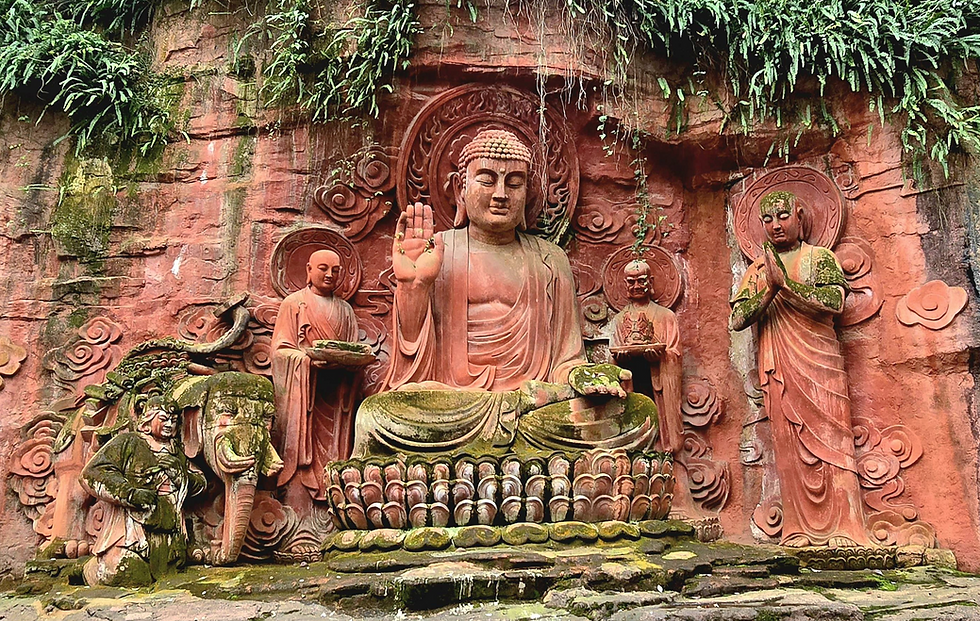Mount Emei Red Cliff Carvings
- Shannon
- May 9
- 3 min read
Updated: Jul 30
The Spiritual Legacy of Mount Emei’s Timeworn Reliefs
The Red Cliff Carvings, also referred to as the Red Cliff Grottoes, are indeed ancient but their exact age is not definitively documented. Based on the creation of the nearby Leshan Buddha, these carvings likely date between 618AD and 960AD. They are located on the northern cliffs of the Emei Mountain Range, one of the Four Sacred Buddhist Mountains of China and is a UNESCO World Heritage Site. The cliffs are deeply revered by Buddhists, as Mount Emei is associated with Buddha’s teachings and home to one of the oldest Buddhist temples in China.

The carvings, exquisitely etched into the naturally rich red sandstone, have withstood centuries of weathering, yet still retain a remarkable level of detail and spiritual gravity. Scholars believe these intricate reliefs illustrate the story of Samantabhadra's Bodhisattva, a sacred narrative uniquely tied to Mount Emei, one of the Four Sacred Buddhist Mountains of China. In Mahāyāna Buddhism, Samantabhadra (known as Pǔxián in Chinese) represents the embodiment of practice and meditation, often portrayed seated on a white elephant with six tusks, a symbol of overcoming the six sense objects. According to legend, Mount Emei is where Samantabhadra attained profound spiritual realisations, transforming the mountain into a powerful place of pilgrimage.

The term Bodhimanda refers to the "seat of enlightenment", the specific place where a bodhisattva attains insight or carries out their sacred vows. In this case, the carvings not only serve as artistic expressions but also as sacred storytelling devices, chronicling the compassionate journey of a bodhisattva who vows to postpone their own nirvana. Rather than entering a final liberation from the cycle of rebirth, Samantabhadra chooses instead to remain in the world, guiding sentient beings toward enlightenment. This selfless resolve is at the heart of Mahāyāna ideals and is poetically immortalised in the flowing lines and symbolic motifs carved into the mountain’s stone face.
While the Red Cliff Carvings are a place of spiritual devotion, they are also wrapped in mysterious folklore. According to local legends, the cliffs were not just home to Buddhist teachings but were also associated with darker tales of sacrifice and revenge. One of the most well known stories involves a devout monk who once lived in the Baoguo Temple, which sits at the base of the cliffs. As the story goes, this monk was an extremely gifted artist and he was entrusted with the task of carving the sacred images on the cliff faces. But as he worked, the monk became obsessed with his task and soon, the spirits of the mountain began to speak to him, demanding more intricate and elaborate carvings.
Driven by the belief that his work would bring him closer to enlightenment, the monk continued carving late into the night, ignoring warnings from other monks about the dangers of working alone in the mountains after dark. One stormy evening, it is said that the monk’s soul was claimed by the mountain gods and his body was found lifeless at the foot of the cliffs the next morning. Some believe that his spirit is still bound to the cliffs and on certain nights, visitors have reported hearing faint whispers or seeing fleeting shadows around the carvings.
The Xiujia Waterfall is located just across the river from these beautiful, ancient carvings
The Red Cliff Carvings on Mount Emei are a must-see for anyone intrigued by Chinese history, Buddhist spirituality or sacred art. These intricate reliefs are enduring testaments to centuries of devotion, capturing stories of compassion, sacrifice and enlightenment. Set against the serene backdrop of Mount Emei’s mist-covered slopes and quiet forest paths, the site offers a deeply reflective experience. Whether drawn by the spiritual symbolism or the craftsmanship itself, visitors often find themselves moved by the stillness of the mountain & the timeless narratives etched into its cliffs.

🗺️ Location
Qi Li Ping Ban Shan, Eshanzhen, Mount Emei, Sichuan
🚆 How to get there
To get to the cliff carvings from Emeishan City, you can catch Bus No. 5 via the Baoguo and Fuhu Temples for about 1.5 yuan. The buses depart every 10 minutes. For ease, I recommend taking a Didi taxi for about 20 yuan, the journey will take approximately 25 minutes. If you're keen, you can walk through Emei for an hour and a half.
⭐ Attraction Info
This attraction is not part of any temple complex and is free to visit at anytime. It is right beside the Xiujia Waterfall in Yingbin Square.























